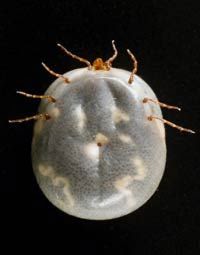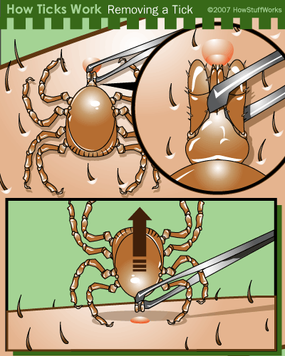Quck answer
Ticks are small, blood-sucking arachnids that can transmit diseases to humans and animals. They attach themselves to the skin of their host and feed on their blood. Ticks have a complex life cycle that includes four stages: egg, larva, nymph, and adult. They are attracted to their hosts by carbon dioxide, body heat, and other chemicals. Once attached, they secrete a cement-like substance to hold themselves in place and feed for several days. Ticks can transmit diseases such as Lyme disease, Rocky Mountain spotted fever, and tick-borne encephalitis. Prevention includes wearing protective clothing, using insect repellent, and checking for ticks after spending time in wooded or grassy areas.
Wild Animals
Removing Ticks

Tweezers may not work on an engorged tick’s swollen abdomen.
Photo courtesy CDC/Dr. Amanda Loftis, Dr. William Nicholson, Dr. Will Reeves, Dr. Chris Paddock
Generally, it takes a while for hard ticks to spread diseases to humans. Some diseases only appear after the tick has been attached for more than four hours. The majority of Lyme disease infections occur after the tick has been attached for more than a day. Therefore, it’s important to check yourself and family members for ticks regularly, especially when in areas where ticks are likely to reside, such as:
- Tall grass
- Dense shrubs
- Wooded areas
Since tick larvae usually lurk at ground level, it’s a good idea to check for them after sitting on the ground. Ticks can also be present after bagging leaves or carrying wood. Checking for ticks every two to three hours is ideal, as it usually takes four hours for a tick to infect. It’s important to pay special attention to areas such as behind the ears, folds in the skin, and the scalp. Nymph ticks are difficult to spot, and they’re responsible for most Lyme disease cases.
It’s easier to remove ticks before they’ve attached themselves for too long. The tick’s abdomen will become more swollen, making it harder to remove without squeezing the tick. Additionally, the tick’s cement-like saliva hardens as it feeds, making removal more difficult.

Use tweezers to remove ticks by pulling them straight out as close to the skin as possible.
If you find a tick, follow these steps:
- Use a pair of tweezers to grab the tick where it attaches to the skin. If you’re frequently in tick-infested areas, it’s best to keep a pair of tweezers solely for tick removal. Always disinfect them afterward.
- Slowly and firmly pull the tick straight out, avoiding jerking or twisting the tick. Do not squeeze the tick’s abdomen.
- Thoroughly clean the area with soap and water.
- If possible, keep the tick. It may help with a more accurate diagnosis if you become ill.
Common old wives’ tales about tick removal, such as using rubbing alcohol, nail polish remover, or a lit match, are not effective. These methods may cause the tick to regurgitate, spreading infectious material into the bite.
Although prompt tick removal significantly reduces the risk of illness, preventing tick bites altogether is a better strategy. Next, we’ll examine how to prevent tick bites and control tick populations.
FAQ
1. What are ticks?
Ticks are small, blood-sucking arachnids that belong to the same family as spiders and mites. They feed on the blood of animals and humans, and can transmit diseases such as Lyme disease and Rocky Mountain spotted fever.
2. How do ticks find their hosts?
Ticks use a variety of methods to find their hosts, including detecting carbon dioxide, body heat, and movement. They often wait on the tips of vegetation and attach themselves to passing animals or humans.
3. How do ticks attach to their hosts?
Ticks use their mouthparts to attach themselves to their hosts. They secrete a cement-like substance that helps them stick to the skin, and then insert their feeding tube into the host’s skin to begin feeding on their blood.
4. How long do ticks feed?
The length of time that ticks feed can vary depending on the species and the size of the tick. Some ticks can feed for several days, while others may only feed for a few hours.
5. What diseases do ticks transmit?
Ticks can transmit a variety of diseases, including Lyme disease, Rocky Mountain spotted fever, and tick-borne encephalitis. These diseases can cause a range of symptoms, from mild to severe.
6. How can you prevent tick bites?
To prevent tick bites, it is important to wear protective clothing, use insect repellent, and avoid areas where ticks are commonly found, such as tall grass and wooded areas. After spending time outdoors, it is also important to check your body for ticks and remove them promptly if found.
7. How do you remove a tick?
To remove a tick, use a pair of fine-tipped tweezers to grasp the tick as close to the skin as possible. Pull upward with steady, even pressure, being careful not to twist or crush the tick. Wash the bite area with soap and water after removing the tick.
8. Can ticks live indoors?
While ticks are typically found outdoors in areas with tall grass and wooded areas, they can sometimes be brought indoors on pets or clothing. It is important to check pets and clothing for ticks after spending time outdoors.
9. Can ticks bite through clothing?
While ticks cannot bite through clothing, they can climb up clothing and attach themselves to exposed skin. Wearing long pants and sleeves can help prevent tick bites.
10. Can ticks be killed with insect repellent?
Some insect repellents may be effective at repelling ticks, but they are not always 100% effective. It is still important to check for ticks after spending time outdoors.
11. What should you do if you develop symptoms of a tick-borne illness?
If you develop symptoms of a tick-borne illness, such as fever, headache, muscle aches, or a rash, it is important to seek medical attention promptly. Early treatment can help prevent complications.





Leave a Reply